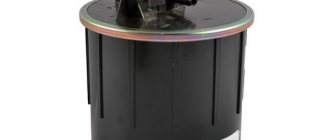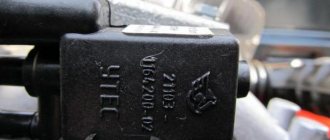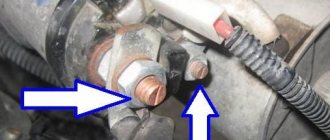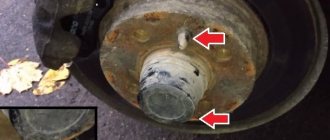The gas tank of any car always contains vapors formed due to a decrease in atmospheric pressure or heating of the fuel. In order to prevent the leakage of fuel vapors into the vehicle, a special gasoline vapor recovery system (VPSU) is installed. Thanks to it, the vapors retained by the adsorber (essentially activated carbon) enter the intake manifold and burn in the engine cylinders. To regulate the amount of gasoline vapor coming from the adsorber to the manifold, a special solenoid valve is used.
Principle of operation
The adsorber itself allows fuel vapors to accumulate in a special place - the separator. As a result, gasoline turns into condensate and goes back to the tank. Vapors that have not undergone treatment go through double valves of the system, one of which prevents fuel from spilling out during an emergency (for example, a coup), and the second “is engaged” in regulating the pressure in the tank. The adsorber purge valve is located under the hood, and the adsorber itself is located on the tank. The control unit ensures the normal operation of the entire system: it ventilates and removes condensation.
Automotive absorber design
In simple words, the absorber design is a plastic jar with a filled filter catching element. The best substance for trapping and neutralizing fuel vapors is activated carbon.
The adsorber consists of:
- Separator. The separator captures gasoline vapors and sends them back to the fuel tank.
- Gravity valve. The gravity valve protects against fuel overflow if the car overturns. The valve blocks the movement of fuel.
- Pressure meter. The pressure sensor performs an important function - it monitors the vapor pressure in the fuel tank. When the maximum permissible pressure in the tank is reached, the sensor opens and releases the pressure.
- Filter element (activated carbon). The filter element in a car absorber is carbon in large granules. Large granules allow vapor to pass through the layer of carbon powder and condense.
- Connecting tubes. Connecting tubes serve to connect all structural elements.
- Solenoid valve. The solenoid valve changes the fuel vapor recovery modes.
Design and operation of the adsorber purge valve
The KPA is an electromagnetic locking device that operates from the vehicle’s on-board network. The valve consists of:
- plastic case;
- valve with spring;
- windings;
- metal core;
- connector
When the vehicle's engine is turned off, no voltage is supplied to the valve and it remains in the closed position. That is, on the motor side, the system that captures vapors is blocked. At the same time, the adsorber begins to “collect” vapors. When the power unit starts, voltage is applied to the valve, causing it to open and fuel vapors to enter the intake manifold. As soon as the ignition is turned off, the control unit is de-energized and the pipeline is closed: no vapors enter the receiver.
Cars of a high price category have a more complex evaporation system. Such machines have special sensors that can “calculate” the amount of air and vapor as a percentage. This allows you to more accurately control the supply of gasoline to the injector.
Adsorber or Absorber
Both of these names can be found on the Internet and in automotive communities. But in fact, these are two different systems, and it is the adsorber that is installed on the car. Therefore, calling this device an absorber is not correct.
Adsorbers are used both in industry and in the automotive industry.
Moreover, starting with the introduction of EURO 2 toxicity standards, these systems are mandatory for installation on vehicles.
What is an adsorber for?
The adsorber is designed to reduce environmental pollution from gasoline vapors. Everyone knows that gasoline evaporates very well.
This also happens to him in the gas tank of a car.
This increases the pressure in the fuel tank, which is a problem.
To solve this problem, the gas tank must be connected to the atmosphere. Thanks to this, we will be able to maintain the pressure in the tank close to atmospheric.
But if we simply connect the tank to the atmosphere, then the gasoline will evaporate directly into the environment, causing harm to the environment.
Older cars did not have an adsorber system. Therefore, the smell of gasoline was almost always felt near them. With the introduction of EURO 2 standards, this became unacceptable and all cars were required to install gasoline vapor recovery systems.
In simple terms, on cars without an adsorber, gasoline evaporates into the atmosphere, and on cars with an adsorber, these vapors are burned (oxidized) in the engine cylinders.
In simple terms, an evaporative emission control (EVAP) system is a fuel tank ventilation system, usually consisting of:
- Gravity valve
- Adsorber
- Controlled canister purge valve
- Pipelines
Gravity valve of the adsorber
The gravity valve is a mandatory element of the system. It prevents fuel from the gas tank from entering the adsorber when the vehicle rolls over.
It can be installed both in the gas tank and outside it. For example, on a Chevrolet Niva it is installed near the filler neck, and on a Chevrolet Lacetti in the gas tank
Where is the adsorber located?
The principle of operation of the adsorber on different cars is the same, the only difference is in the shape and location of the adsorber and the purge valve. Some have it installed in the engine compartment. For example, VAZ 2115
And, for example, in a Chevrolet Lacetti - under the bottom near the rear wheel
How does the adsorber work?
Fuel vapor from the tank through the gravity valve enters the adsorber (a container with activated carbon) through a fitting labeled “TANK”, where it accumulates while the engine is not running. The second canister fitting with the inscription “PURGE” is connected by a tube to the canister purge valve, and the third with the inscription “AIR” is connected to the atmosphere.
1 – AIR vent fitting, 2 – TANK fitting for the tube for supplying fuel vapors from the tank to the canister, 3 – PURGE fitting for the tube for removing fuel vapors from the adsorber to the valve
It looks more clear as follows.
The car is parked. The gasoline in the tank gradually evaporates, increasing the pressure. Excess pressure is released along the path - gravity valve-adsorber-atmospheric fitting of the adsorber.
That is, the pressure is released into the atmosphere, but fuel vapors condense on the activated carbon of the adsorber.
When the engine is stopped, the purge solenoid valve is closed, and in this case the adsorber does not communicate with the intake manifold.
When the engine is running, the ECU, controlling the solenoid valve, purges the adsorber with fresh air due to the vacuum in the intake manifold. That is, vapors are sucked out of the adsorber, and fresh air enters the adsorber through the atmospheric fitting.
Gasoline vapors are mixed with air and discharged into the intake manifold behind the throttle and then enter the engine cylinders.
Therefore, the adsorber can be figuratively compared to a self-cleaning sump filter.
How does the adsorber valve work?
Many people mistakenly believe that when the engine starts, voltage is immediately applied to the canister valve and it opens, purging the canister. I even saw “manuals” and “training videos” about this. In fact, the purge valve is controlled by the ECU using special algorithms based on readings from temperature, air flow, etc. sensors.
The greater the engine air consumption, the longer the duration of the ECU control pulses and the more intense the purging.
It is impulses, and not just the supply of voltage! Therefore, there is such a thing as “adsorber purge duty cycle,” which ranges from 0% to 100%.
Here is the duty cycle of the canister purge in the Chevrolet Explorer diagnostic program. During the entire trip, this is only the first signal from the ECU to purge, equal to only 6%.
The adsorber valve can be figuratively compared to a water valve rather than a valve. That is, the adsorber valve does not just open/close, but regulates the intensity of gas passage.
Adsorber malfunctions
A faulty adsorber can lead to two of the most common problems:
1. Since the adsorber is directly connected to the pressure in the gas tank, if it malfunctions, you may hear popping noises in the gas tank, and you may also hear a characteristic hissing sound when you unscrew the filler cap.
2. If the canister valve is faulty, very unstable idle may occur. Especially when warming up. This is exactly the case I diagnosed in this video.
How to check the adsorber valve
The principle of checking on most cars is the same, but we will look at the example of the Chevrolet Lacetti.
Problems with the canister purge valve can be divided into several main points:
- impulses do not arrive to the valve
- Valve coil failure
- valve stuck open
- valve jamming in closed position
You can check the integrity of the wiring and the functionality of the valve using both software methods and a conventional multimeter. But you can only check the valve’s tightness physically.
It is very easy to check the pulses, wiring and valve winding with the Chevrolet Explorer program, in the “mechanism control - canister purge valve test” tab. When you click on the “ON” button in the program diagram, we will see the following signals
This means that the ECU is giving a command to the valve. At the same time, the sound of clicks will emanate from the valve in time with these signals, which, in turn, means that the pulses reach the valve and the winding is intact, since the valve is activated.
By the way, if you don’t have a diagnostic adapter yet, then I advise you to definitely read the diagnostics section and purchase an adapter.
The electrical part is OK. We checked this. But to be sure that the valve is not physically jammed, it can be removed and checked. It is very easy to dismantle and it takes me no more than 30 seconds.
Two tubes and a connector with two wires are connected to the valve. The valve itself is not even screwed on, but simply inserted into its working place.
In the photo one tube has already been removed.
To remove the valve, just pull off the two tubes marked with a green and a red arrow (the red one has already been removed, and the green one is hard to see from this angle). The tubes are removed simply and easily without any clamps.
- Then press the metal lock and unfasten the wire block (shown by the yellow arrow)
- After this, press on the fitting shown by the red arrow and the valve will come out of its seat.
Signs of a malfunction of the control unit
First, start the engine: at idle or in cold weather, you will hear a characteristic, barely audible chirping sound. It indicates that the valve is working properly. In order not to confuse this sound with the noise from a working timing belt, sharply press the gas. The character of the chatter should not change. The following signs indicate a malfunction of the control unit:
- lighting of the CHECK signal on the instrument panel;
- determination of error PO441 during testing;
- increased gasoline consumption;
- unstable operation of the power unit when driving;
- unstable idle;
- increase in CO2 content;
- a hissing sound when unscrewing the tank lid (a vacuum has appeared);
- the appearance of a fuel smell in the cabin.
Absorber valve: what is it for and what does it affect?
The valves in the absorber are a technically simple device that operate differently depending on whether the engine is running or not. Like all valves, it must open and close.
When the absorber cavity is clogged or some other malfunction occurs, the valve malfunctions. With a faulty adsorber valve, serious vehicle damage can occur because pressure is not released from the fuel tank and the cavity is not purged.
Symptoms of Absorber Valve Problems
There are several signs and symptoms that can help identify the technical condition of the valve:
- The fuel gauge shows either a full tank or an empty one.
- After starting the engine, after 5-10 minutes the revolutions begin to fluctuate.
- At idle speed, when you press the pedal, the car begins to stall.
- The engine does not gain speed when driving. It takes a long time to accelerate.
- When opening the gas tank cap, a vacuum is felt and a whistle is heard.
- Increased fuel consumption.
- When it’s cold (when the engine is running but not yet warmed up), knocking noises from the absorber are heard, as if valves are knocking.
The cause of absorber failure is not always the valve. This may be severe contamination of the absorbent element, in this case coal. Gases should easily pass through the coal granules and condense there.
The valve is very cheap. Therefore, it is possible to change if signs of improper engine operation are detected. You can also replace the adsorber filter element with your own hands: disassemble it, pour out the old coal, pour in new coal in large granules.
Valve check on site
You will need a tester (voltmeter, multimeter) and a screwdriver. The KPA itself is installed on the radiator frame. The device can be recognized by seeing two tubes approaching it, through which the evaporation moves. Further:
- disconnect the electrical connector from the control unit by releasing the block lock;
- using a multimeter, check for the presence of voltage by touching the negative (black) probe of the device to ground, and the red probe to “A” (the letter on the block connector);
- turn on the ignition: the multimeter should show the vehicle's on-board voltage. If not, check the wiring.
Valve repair
Checking and purging the valve
The first signs that the Kalina adsorber needs to be repaired are the appearance of a persistent smell of gasoline in the car interior and difficulties that arise during draining the fuel. For repairs, it is necessary to remove the adsorber and disassemble it. Since the device is usually solid, for disassembly you will need to cut off the cover. This can be easily done with a regular file. After repair work has been carried out and replacement of the main parts, the cover is usually simply sealed. For complete sealing, the seams are treated with resin. The resin dries within 12 hours. After this, it can be lightly sanded to bring the filter into proper shape.
Spent and unusable coal is poured out of the adsorber. Foam rubber is suitable as intermediate filters. Remove the old filters and replace them with new ones, prepared in advance. Some craftsmen believe that foam rubber is not particularly effective and will allow all the dirt and coal to pass through, so filters can be made from felt. You can place a piece of cotton fabric between the device and the felt, which will prevent small threads from getting into the system. The resulting gaskets are glued to the base and treated with sealant.
New coal can be obtained from gas mask boxes. It is important that it is completely dry, so dry it thoroughly before adding it to the system.
When the dry coal is filled in, felt filters are installed again. All the plates and springs are put in place, and then the filter itself. As can be seen from the above, it is not difficult to diagnose and repair the Kalina absorber valve; you can do it yourself. Good luck!
How to check the adsorber valve removed from the car
You need to take a medical syringe of suitable volume, simply pull out the piston 2-3 cm and connect it to the outlet fitting. If you press on the piston, it will move with difficulty, which indicates that there is pressure in the valve. Now connect the battery to the electrical part of the control unit and press the piston again: the resistance should disappear. If this does not happen, you will have to buy a new valve.
The engine fuel system is designed to supply an optimal air-fuel mixture. One of the components of this system is an absorber, and the article discusses its structure, purpose, main malfunctions and methods for checking its performance.
There are problems, but everything is whole
Having the above symptoms, and having checked the integrity of the hoses, we move on to the adsorber valve. How to check it?
1) First of all, disconnect the negative terminal from the battery;
2) Remove the absorber (in most cases it is located on the right side of the engine near the car’s air system);
3) Now turn off the electrical power to the valve itself;
4) Remove the hoses (inlet and outlet);
5) Then we try to blow air into the system through the valve (into the holes for the hoses);
6) If it is working, then when the power is removed from it, it will be blocked, i.e. You won't be able to blow it out;
7) Check further. We connect two wires from the battery to the power contacts on the valve. At the same time, you should hear an opening sound (click);
8) When connected to the source, we try to blow air into it. It should work without problems, if not, then it is closed;
9) Reset the power, if it closes again, then it is 100% working.
By checking the adsorber valve in this way, you can determine its performance at almost 100%. Of course, there may be nuances in which this will be more difficult, but the principle is the same everywhere. Thus, we have described in detail how to check this device.
If it is faulty, then you need to buy a new one - the cost is about 2000 rubles, so before you immediately change it, check it. If the problems lie in the operation of the electronic control unit, then this is a completely different story and everything becomes much more complicated.
Now a short video of a VAZ engine.
I’ll finish here, read our AUTOBLOG.
(
5 votes, average: 4.40 out of 5)
Device
Engines with distributed fuel injection first appeared on front-wheel drive Ladas, starting with the 2111 model. They differ greatly from their carburetor predecessors in a more complex power system design. It consists of 2 subsystems: fuel supply to the fuel rail and gasoline vapor recovery. One of the components of the latter is the adsorber in the VAZ-2114.
A solenoid valve is placed on top of the plastic cylinder and is controlled by the engine control unit. This part is removable and secured with plastic latches. The valve body is rectangular, and there are 2 fittings (inlet and outlet) and a connector for connecting the ECU.
The hoses are secured to the fittings using clamps. The incoming one is connected to the gravity valve and then to the separator and the gasoline tank. The outlet is connected to the throttle valve assembly.
Why is an adsorber needed in a car and how to check its serviceability?
To improve the environmental friendliness and safety of a car, a special adsorber device is used, the main purpose of which is to capture gasoline vapors that appear when the car engine is turned off. An adsorber is installed in the ventilation system, which significantly improves the environmental friendliness of the machines.
Adsorber device
The adsorber consists of absorbent elements, a gasoline vapor separator, a ventilation valve, and numerous hoses and pipelines that connect such a filter to the intake manifold and gas tank. Also, modern models of adsorbers have a purge solenoid valve, which is installed on the pipes going into the intake manifold.
Principle of operation
When the engine is turned off, gasoline evaporates in the gas tank, after which such saturated vapor rises up and accumulates at the neck. This is where the adsorber separator is located, which separates the condensate that flows back into the gas tank. The remaining saturated vapors enter the adsorber, accumulating on its surface.
As soon as the engine starts and its speed rises, the purge solenoid valve opens, through which air is supplied due to vacuum. This ensures that the manifold is purged; the gasoline and saturated steam accumulated in the adsorber are supplied to the intake manifold and then burned in the engine.
Signs of malfunctioning adsorbers
Like any other mechanism, the adsorber can fail during vehicle operation, which forces you to contact a service center or carry out independent repairs.
Problems with the adsorber can be determined by the appearance of a persistent smell of gasoline near the car or in the car interior.
In this case, a comprehensive diagnosis is necessary, since this also indicates damage to the fuel line.
If the adsorber is damaged, saturated gasoline vapors accumulate in the gas tank, which leads to an increase in pressure. If a distinct hissing sound is heard when you open the tank lid, then this is one of the signs of a problem with the adsorber; such a machine needs to be taken to a service center and repaired.
Some modern cars are equipped with a special canister sensor that detects such breakdowns, and when they appear on the dashboard, the Check Engine lights up. In this case, the car needs to be taken to a service center, computer diagnostics performed, errors read and deciphered, and then the adsorber replaced.
If problems occur with the adsorber filter, problems with starting the engine may occur, this is especially true in cases where there is little fuel left in the gas tank. Remember that long-term operation of a car with a failed adsorber can lead to fuel pump malfunctions.
Operating principle
So, what does the process of purging the adsorber in a VAZ 2114 look like? When the car is parked, gasoline from the tank evaporates and first enters the separator. There, some of the vapor turns into liquid and flows back. The remaining gaseous fuel, moving along the line, enters a sealed adsorber. Activated carbon absorbs vapors and holds them until the engine starts.
Do-it-yourself absorber valve replacement
If signs of malfunction are detected, the valve will need to be repaired or replaced. The adsorber valve is inexpensive and easy to replace. To dismantle you need to have a pair of Phillips screwdrivers and know where the canister purge valve is located. Operating procedure:
The markings on the old and new valves must match.
- Open the hood and find a cylindrical device - an adsorber.
- Remove the negative terminal from the battery.
- Disconnect the wire block by pressing the latch and pulling it towards you.
- Loosen the valve.
- Remove the fittings under the latch and disconnect the hoses.
- Remove the valve together with the bracket from the adsorber.
- The new valve is installed in the reverse order.
Thus, even such a small element as the adsorber valve performs important functions and its malfunction can seriously disrupt the operation of the entire engine. Therefore, it is important to monitor the condition of your car and carry out diagnostics on time.
Why is an adsorber needed on a VAZ-2114?
The main purpose of the fuel vapor recovery subsystem and adsorber as a component of this system is to make the car less harmful to the environment and to comply with international environmental standards Euro-2 and Euro-3.
The adsorber does not affect the technical characteristics of the VAZ-2114 in any way. It is designed to prevent gasoline vapors from leaving the power system circuits. This measure allows you to use the fuel supply a little more efficiently. There will be no savings like when using forced idle, but you can drive 1-2 kilometers during long-term operation.
Canister valve: malfunctions, diagnostics and repairs
It is quite obvious that on any car with an adsorber (Priora, Kalina or foreign car adsorber), the adsorber valve, if it fails, can affect the operation of the internal combustion engine. In other words, both on a domestic budget model (for example, the Kalina canister purge valve) and on a high-class car, this element in some cases is the cause of engine malfunctions.
In fact, a malfunction of the purge valve can damage the fuel pump. Also, if the adsorber ventilation is impaired, fuel may accumulate in the intake manifold, mixture formation is disrupted, the power plant does not produce full power, etc. Problems often appear when starting a cold internal combustion engine; the load on the starter increases when trying to start the engine.
The main symptoms of a malfunctioning adsorber valve:
- the engine is not stable at idle;
- RPM fluctuates at XX;
- engine power lost;
- increased fuel consumption;
- when the internal combustion engine is running, the adsorber valve does not make sounds;
- When unscrewing the gas tank cap, a hissing sound is heard;
- there is a smell of gasoline near the car and in the cabin;
The appearance of such signs may well be caused by other reasons, but often this indicates impaired ventilation of the adsorber. It is for these reasons that experts recommend regularly checking the adsorber valve.
A mechanical check is needed when, when the engine is idling or cold, you can hear the adsorber valve clicking. If extraneous sounds appear at idle, you can sharply press the gas pedal.
If the clicking sound does not change, then there is a high probability that these sounds are produced by the adsorber valve. So, if the adsorber valve is knocking, first you can try cleaning its adjusting screw, and then tighten this screw.
Next, adjust the absorber valve. To adjust the adsorber valve, turn the adjustment screw 0.5 turns. It should be taken into account that if you tighten the screw too much, the ECU may mistake this for a malfunction and an error will appear.
However, if the adjustment of the adsorber valve is carried out correctly, this valve is practically knock-free. The main thing is to take into account the individual characteristics of a particular valve on a specific car model.
Removal and installation
Dismantling of the part is carried out according to the following algorithm:
Step 1. Disconnect the clamp from the negative terminal of the battery and block the wheels using the parking brake (“put the handbrake on”).
Step 2. Remove the wire from the adsorber valve (VAZ-2114).
Step 3. Using a Phillips screwdriver, loosen the clamps and remove the hoses from the fittings. The latter are made of plastic and break easily.
Step 4. Use a flathead screwdriver to pry the latch on the valve body and remove it.
Step 5. Loosen the clamp securing the adsorber body and pull out the latter.
Step 6. Unscrew the 3 nuts securing the front shock absorber from the side of the expansion tank and remove the plate on which the adsorber is attached. This step is only necessary if the part is completely removed from the power system.
Adsorber valve: how it works and works, main malfunctions
The engine power supply system of a modern car is a complex that combines a number of devices and elements. Among them are the main parts (for example, the fuel tank, fuel lines, fuel pump, injectors, etc.), as well as auxiliary systems.
As for the adsorber itself, an important element in its design is the purge valve. Next, we will look at what an adsorber valve is, what it is needed for, how it is designed and works, as well as what signs of a malfunction of the adsorber valve indicate possible problems.
Malfunctions, symptoms and solutions
Due to the extreme simplicity of the design, the adsorber in the VAZ-2114 has two malfunctions: it is clogged or the solenoid valve does not work. If this part breaks, the following problems may appear in the operation of the car:
- Unstable engine operation at idle (speeds fluctuate). To check, you need to disconnect the hose between the throttle assembly and the purge valve and plug it. A candle, for example. If the engine speed does not become normal, then the adsorber is clogged.
- When you unscrew the gas tank cap, you hear a hissing sound or gasoline vapors squeeze it out of the filler neck.
- Poor acceleration due to decreased pressure in the fuel line. If the purge valve is faulty, atmospheric air does not enter the tank. This leads to the fact that when the engine is running, a vacuum is created in the gas tank, interfering with the operation of the fuel rail. Also, a strong vacuum can lead to the tank being severely deformed by the force of atmospheric pressure.
- No repetitive clicking noises during overclocking.
Checking the adsorber. 3 ways to check the adsorber
Many car owners may be interested in the question of how to check the adsorber and its purge valve when the diagnostics showed it to be faulty (an absorber error popped up).
It is quite possible to make such a diagnosis in a garage, however, for this it will be necessary to dismantle either the entire adsorber or just its valve.
And to carry out such a test, you will need metalworking tools, a multifunctional multimeter (to measure the insulation value and the “continuity” of the wires), a pump, and a 12 V power source (or a similar battery).
What is an adsorber and what is its operating principle?
To understand why an adsorber and absorber are needed, you need to dive into the theoretical part of the devices and understand how the device works.
Gasoline engines have a system that minimizes the release of fuel mixture vapors into the environment. In a car, the adsorber valve is one of the main elements that prevents the entry of fuel mixture vapors.
An adsorber is something like an air purification element and is a regular container that is filled with activated carbon, which acts as a filter. It is connected directly to the fuel tank using tubes.
The main cleaning work is carried out by the separator. The vapors that are formed from the fuel mixture enter it.
The work of the adsorber is that not all vapors have time to get into the separator and therefore are sent to the adsorber in the car.
How to replace lamps on a Touareg?
The adsorber device allows the received vapors to pass through the filled activated carbon, and after their accumulation, go directly to the intake manifold.
When the valve opens, air enters, which mixes with the vapors of the fuel mixture and goes into the intake manifold of the car. This is how the adsorber is purged. Below is a diagram of the adsorber device.
Fuel vapors can only be absorbed when the engine is turned off. When the engine is running, the ECU opens the canister valve and performs ventilation.
The condensate that has managed to accumulate passes from the adsorber valve directly into the internal combustion engine and is burned out.
The job of the adsorber valve is to provide ventilation and also direct condensate into the internal combustion engine.
Pros and cons of the device
Like any other unit, the adsorber has its own positive and negative qualities that the car enthusiast should know about:
1. Advantages:
- No harmful fuel vapors enter the atmosphere.
- Fuel is saved because the vapors do not escape into the atmosphere, but return back to the engine for combustion.
- The unpleasant smell of gasoline disappears from the passenger compartment (this effect does not always occur).
2. Disadvantages:
- The adsorber has a substantial size, so it takes up a certain space under the hood.
- The engine operates unstably, and “swimming” occurs at idle (one of the main signs of a failed adsorber).
- High price. Installing an adsorber increases the cost of the car.
- Risk of the tank cap “shooting out”. This is possible in the event of a breakdown of the adsorber and prolonged accumulation of fuel gases in a confined space.
- Risk of deformation of the fuel pump. Ignoring the failure of the device also leads to this problem.
- Risk of accumulation of a flammable mixture in the intake manifold due to the inability of the adsorber to perform its functions. As a result, the stability of the motor is disrupted.
Symptoms of a problem
The canister purge valve may break down because the canister device is in constant operation. Its breakdown can affect the operation of the engine to the point where the engine requires repair. In the early stages, the breakdown manifests itself in increased fuel consumption, as well as loss of power. If the valve malfunctions, it can also damage the vehicle's fuel pump.
Complete removal of the adsorber from the power system
Some VAZ 2114 owners decide to completely remove this part from their car for reasons of savings and to prevent future malfunctions. There are two ways to do this.
Method 1. After completely removing the adsorber from the VAZ-2114, the hose leading to the throttle valve assembly is closed using a plug. A fuel filter from any VAZ carburetor engine is inserted into the hose running from the gas tank to the adsorber.
Method 2. The adsorber is removed along with the support. The hoses previously connected to it are closed using plugs. A small hole (1-2 mm) is drilled in the standard gas tank plug to connect the cavity to the atmosphere. You can also use the cap from a carburetor “eight” or “nine” to depressurize the fuel tank.
After upgrading the power system, it may be necessary to update the firmware of the engine control unit, since it will perceive the absence of an adsorber as a malfunction in the engine and switch to emergency operation. This threatens to significantly reduce the traction qualities of the car.
The adsorber in the VAZ-2114 is an important element in the engine power system, which allows you to slightly reduce fuel consumption and eliminate the smell of gasoline in the cabin.
Instructions for checking and independently replacing the canister purge valve on LADA Samara 2114, 2113, 2115 cars.
To perform work on replacing and checking the adsorber purge valve you will need:
Disconnect the wiring block from the canister purge valve.- We connect the negative probe of the multimeter to the “ground” of the car
- Turn on the ignition and check the supply voltage at terminal A of the wire block. The voltage should be 12V. If the voltage is less or absent, you need to check the battery charge, the health of the power circuit and the serviceability of the computer.
- Loosen the clamp securing the hose to the valve and remove the hose. In this case, you need to make sure that the hose does not break off.
- Using a screwdriver, remove the valve from the adsorber.
- To check the functionality of the valve, you need to apply 12V voltage to the valve terminals. The plus goes to pin A, and the minus goes to pin B. After power is applied, the valve should open with a characteristic click. If this does not happen, the valve must be replaced.
- Before installing a new valve, check the O-ring. A damaged ring must be replaced.
- We install the new valve in place in the reverse order.
Solenoid valve malfunctions
If the adsorber is in uninterrupted mode almost all the time, the purge valve can easily stop functioning. This will damage the fuel pump. If the adsorber does not ventilate properly, gasoline will gradually accumulate in the intake manifold.
This leads to some rather unpleasant “symptoms”:
- At idle, so-called dips appear.
- Traction is impaired (it seems that the vehicle is constantly losing power).
- When the engine is running, the sounds of the valve operating are not heard.
- Fuel consumption increases noticeably.
- When opening the gas tank cap, a hissing and whistling sound is heard.
- The fuel tank sensor literally lives its own life (it can show that the gas tank is full, and a second later - that there is nothing in it).
- An unpleasant gasoline “aroma” appears in the car interior.
Sometimes the filter element, on the contrary, makes too loud sounds, which are also not the norm. To make sure that the cause is a faulty valve and not a timing belt, just press the gas sharply. If the sound effect remains the same, then most likely the problem is in the canister valve.
In this case, it is recommended to slightly tighten the adjusting screw of the device. However, you need to tighten it no more than half a turn. Holding too tightly will result in a controller error. If such manipulations do not help, then you need to conduct a more detailed diagnosis.
How to repair the adsorber and valve
It’s worth noting right away that in most cases both the adsorber and the valve cannot be repaired; accordingly, they need to be replaced with similar new components. However, as for the adsorber, in some cases, over time, the foam in its body rots, which is why the carbon contained in it clogs the pipelines and the solenoid valve of the EVAP system.
Rotting of foam rubber occurs for banal reasons - from old age, constant temperature changes, exposure to moisture. You can try to replace the foam separator of the adsorber. However, this cannot be done with all units; some of them are non-separable.
If the adsorber body is rusted or rotten (usually also due to old age, temperature changes, constant exposure to moisture), then you can try to restore it, but it is better not to tempt fate and replace it with a new one.
Checking the valve using a homemade tester
Similar reasoning is valid for the solenoid valve of the gasoline vapor recovery system. Most of these units are non-separable. That is, the electromagnetic coil is sealed into its body, and if it fails (insulation breakdown or winding break), it will not be possible to replace it with a new one.
This is exactly the situation with the return spring. If it has weakened over time, you can try to replace it with a new one, but this is not always possible. But despite this, it is still better to perform a detailed diagnosis of the adsorber and its valve in order to avoid expensive purchases and repairs.
Some car owners do not want to pay attention to the repair and restoration of the gasoline vapor recovery system, and simply “turn off” it. However, this approach is not rational. Firstly, this really affects the environment, and this is especially noticeable in large cities, which are not known for their clean environment anyway. Secondly, if the EVAP system does not work correctly or does not function at all, then under pressure gasoline vapors will periodically escape from under the gas tank cap. And this will happen as often as the temperature in the gas tank increases. This situation is dangerous for several reasons.
Firstly, the tightness of the tank cap is broken, the seal of which is broken over time, and the car owner will probably have to periodically buy a new cap. Secondly, gasoline vapors not only have an unpleasant odor, but are also harmful to the human body. And this is dangerous provided that the car is parked in an enclosed area with poor ventilation. And thirdly, fuel vapors are simply explosive, and if they come out of the gas tank while there is a source of open fire next to the car, a fire hazard will arise with very dire consequences. Therefore, there is no need to “turn off” the fuel vapor recovery system; instead, it is better to keep it in working order and monitor the adsorber and its valve.
Conclusion
Checking the adsorber, as well as its electromagnetic purge valve, is not very difficult even for novice car owners. The main thing is to know where these components are located in a particular car, as well as how they are connected. As practice shows, if one or the other unit fails, they cannot be repaired, so they need to be replaced with new ones.
As for the opinion that the fuel vapor recovery system needs to be turned off, it can be attributed to misconceptions. The EVAP system must work normally and ensure not only environmental friendliness, but also safe operation of the vehicle in various conditions.
Source
Symptoms of canister valve failure.
Hello. Today I wanted to talk about the canister purge valve. Or rather, about the symptoms of its breakdowns. Let's look at the example of cars from the VAZ family.
The valve began to be installed on cars with the advent of Euro-2 standards. Vapors from the gas tank enter the adsorber barrel, in which they condense. After starting the engine, the electronic unit controls the valve with a certain frequency, thereby gasoline vapors from the cavity of the adsorber barrel enter the intake manifold, then into the engine and burn out there.
It turns out that gasoline vapors do not enter the atmosphere in this way. On some models, you can hear the valve clicking at idle.
The adsorber purge valve, if it breaks, can cause some inconvenience to the car owner. Symptoms may be the following: freezing or floating speed at idle, shooting in the muffler during acceleration. In this case, the engine malfunction lamp may light up with the error “Incorrect air flow through the canister valve.” Also, when unscrewing the gas tank cap, a whistle may be heard because a vacuum is created.
Usually the valve hangs in the open or closed state. If the valve jams in the open position, gasoline vapors mix with the air entering through the adsorber tank and enter the engine. It should be noted that the adsorber valve, which is installed on Kalina and Granta, is less reliable.
If you tap on a stuck canister valve while the engine is running, it may start working, but this does not always help. In this case, we buy a new one. The cost of the adsorber valve is approximately 400 rubles.
I hope the article will be useful to car enthusiasts.
I would be grateful if
you subscribe to the channel and like the article . If you have any questions, write in the comments, I will try to answer them.
Source











